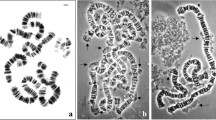Summary
The nuclear structure of parenchymal liver cells of embryo and adult Microtus agrestis was studied in smear and section preparations after staining with Giemsa solution and treatment according to Feulgen, after treatment with ribonuclease and after specific staining of constitutive heterochromatin. In liver cell nuclei only the facultative heterochromatin is heteropycnotic, a sex chromatin body is observable in female but not in male animals. Constitutive heterochromatin is not heteropycnotic in liver cells. Measurements of the relative DNA content showed that nuclei with one sex chromatin body are diploid; tetraploid nuclei possess two and octoploid nuclei four sex chromatin bodies. Solely in the diploid cell nuclei of the intrahepatic gall ducts two large chromocenters are found. The nucleoli in hepatocytes often lie at the perimeter of the nucleus. 17% of the diploid nuclei contain one nucleolus, 59% two nucleoli, 23% three and 1% four. After staining of repetitive DNA, the nucleoli often become stained as well; after treatment with ribonuclease this effect does not occur. The constitutive heterochromatin becomes visible in form of two long, threadlike structures. After longer periods of dissociation the sex chromatin body ceases to be visible. Sex chromatin and constitutive heterochromatin are contiguous to the nucleoli.
Zusammenfassung
Die Zellstruktur von Leberzellen der Erdmaus, Microtus agrestis, wurde nach Giemsafärbung, Feulgenbehandlung, Behandlung mit Ribonuklease und nach Färbung des konstitutiven Heterochromatins untersucht. Das konstitutive Heterochromatin ist in Leberzellen nicht heteropyknotisch, das fakultative Heterochromatin ist im weiblichen Geschlecht als Sexchromatinkörperchen sichtbar. Bestimmungen des relativen DNS-Gehalts ergaben, daß die Zahl der Sexchromatinkörperchen der Ploidie der Zellkerne proportional ist. Die Nukleolen liegen in Hepatozyten oft randständig; in 59% der diploiden Zellkerne sind 2 Nukleolen enthalten. Nach Anfärbung der repetitiven DNS werden oft auch die Nukleolen gefärbt, nach Ribonukleasebehandlung tritt dieser Effekt nicht auf. Das konstitutive Heterochromatin wird in Form von 2 langen fädigen Strukturen sichtbar.
Similar content being viewed by others
Literatur
Arrighi, F. E., Hsu, T. C., Saunders, P., Saunders, G. F.: Localization of repetitive DNA in the chromosomes of Microtus agrestis by means of in situ hybridization. Chromosoma (Berl.) 32, 224–236 (1970).
Beams, H. W., King, R. L.: The origin of binucleate and large mononucleate cells in the liver of the rat. Anat. Rec. 83, 291–297 (1942).
Britten, R. J., Kohne, D. E.: Repeated sequences in DNA. Science 161, 529–540 (1968).
Klinger, H. P., Schwarzacher, H. G.: Sex chromatin in polyploid nuclei of human amnion epithelium. Nature (Lond.) 181, 1150–1152 (1958).
Lee, J. C., Yunis, J. J.: A developmental study of constitutive heterochromatin in Microtus agrestis. Chromosoma (Berl.) 32, 237–250 (1971a).
Lee, J. C., Yunis, J. J.: Cytological variations in the constitutive heterochromatin of Microtus agrestis. Chromosoma (Berl.) 35, 117–124 (1971b).
Nadal, C., Zajdela, F.: Polyploidie somatique dans le foie de rat. I. Le rôle des cellules binucléés dans la genèse des cellules polyploides. Exp. Cell Res. 42, 99–114 (1966).
Natarajan, A. T., Sharma, R. P.: Tritiated uridine induced chromosome aberrations in relation to heterochromatin and nucleolar organization in Microtus agrestis L. Chromosoma (Berl.) 34, 168–182 (1971).
Pera, F.: Struktur und Position der heterochromatischen Chromosomen in Interphasekernen von Microtus agrestis. Z. Zellforsch. 98, 421–436 (1969).
Pera, F.: Mechanismen der Polyploidisierung und der somatischen Reduktion. Erg. Anat. Entwickl.-Gesch. 43 (5) 1–112 (1970).
Pera, F.: Pattern of repetitive DNA of the chromosomes of Microtus agrestis. Chromosoma (Berl.) 36, 263–271 (1972).
Pera, F., Schwarzacher, H. G.: Lokalisation der heterochromatischen Chromosomen von Microtus agrestis in Interphase und Mitose. Cytobiologie 2, 188–199 (1970).
Pera, F., Wolf, U.: DNS-Replikation und Morphologie der X-Chromosomen während der Syntheseperiode bei Microtus agrestis. Chromosoma (Berl.) 22, 378–389 (1967).
Schmid, W.: Heterochromatin in mammals. Arch. Klaus-Stift. Vererb.-Forsch. 42, 1–60 (1967).
Schmid, W., Smith, D. W., Theiler, K.: Chromatinmuster in verschiedenen Zelltypen und Lokalisation von Heterochromatin auf Metaphasechromosomen bei Microtus agrestis, Mesocricetus auratus, Cavia cobaya und beim Menschen. Arch. Klaus-Stift. Vererb.- Forsch. 40, 35–49 (1965).
Schwarzacher, H. G.: Kernstruktur und Geschlechtschromatin menschlicher Zellen in vitro im lebenden Zustand und nach Fixierung. Acta anat. (Basel) 57, 91–104 (1964).
Schwarzacher, H. G.: Sexchromatin in polyploiden Zellen. Hum. Genet. 2, 28–35 (1966).
Schwarzacher, H. G., Pera, F.: Das Problem der Sexchromatin-negativen Zellen. Z. Anat. Entwickl.-Gesch. 132, 18–33 (1970).
Sieger, M., Pera, F., Schwarzacher, H. G.: Genetic inactivity of heterochromatin and heteropycnosis in Microtus agrestis. Chromosoma (Berl.) 29, 349–364 (1970).
Sieger, M., Garweg, G., Schwarzacher, H. G.: Constitutive heterochromatin in Microtus agrestis: binding of actinomycin-D and transcriptional inactivity. Chromosoma (Berl.) 35, 84–98 (1971).
Skinner, L. G., Ockey, C. H.: Isolation, fractionation and biochemical analysis of the metaphase chromosomes of Microtus agrestis. Chromosoma (Berl.) 35, 125–142 (1971).
Sulcin, N. M.: A study of the nucleus in the normal and hyperplastic liver of the rat. Amer. J. Anat. 73, 107–125 (1943).
Walker, P. M. B.: How different are the DNAs from related animals ? Nature (Lond.) 219, 228–232 (1968).
Wilson, J. W., Leduc, E. H.: The occurrence and formation of binucleate and multinucleate cells and polyploid nuclei in the mouse liver. Amer. J. Anat. 82, 353–391 (1949).
Wolf, U., Flinspach, G., Böhm, R., Ohno, S.: DNS-Reduplikationsmuster bei den Riesen-Geschlechtschromosomen von Microtus agrestis. Chromosoma (Berl.) 16, 609–617 (1965).
Yasmineh, W. G., Yunis, J. J.: Repetitive DNA of Microtus agrestis. Biochem. biophys. Res. Commun. 43, 580–587 (1971).
Yunis, J. J., Roldan, L., Yasmineh, W. G., Lee, J. C.: Staining of repetitive DNA in metaphase chromosomes. Nature (Lond.) 231, 532–533 (1971).
Author information
Authors and Affiliations
Additional information
Mit dankenswerter Unterstützung durch das Bundesministerium für Bildung und Wissenschaft der Bundesrepublik Deutschland.
Rights and permissions
About this article
Cite this article
Pera, F. Heterochromatin, repetitive DNS und Nukleolen in Leberzellen von Microtus agrestis . Histochemie 30, 82–96 (1972). https://doi.org/10.1007/BF00303938
Received:
Issue Date:
DOI: https://doi.org/10.1007/BF00303938




